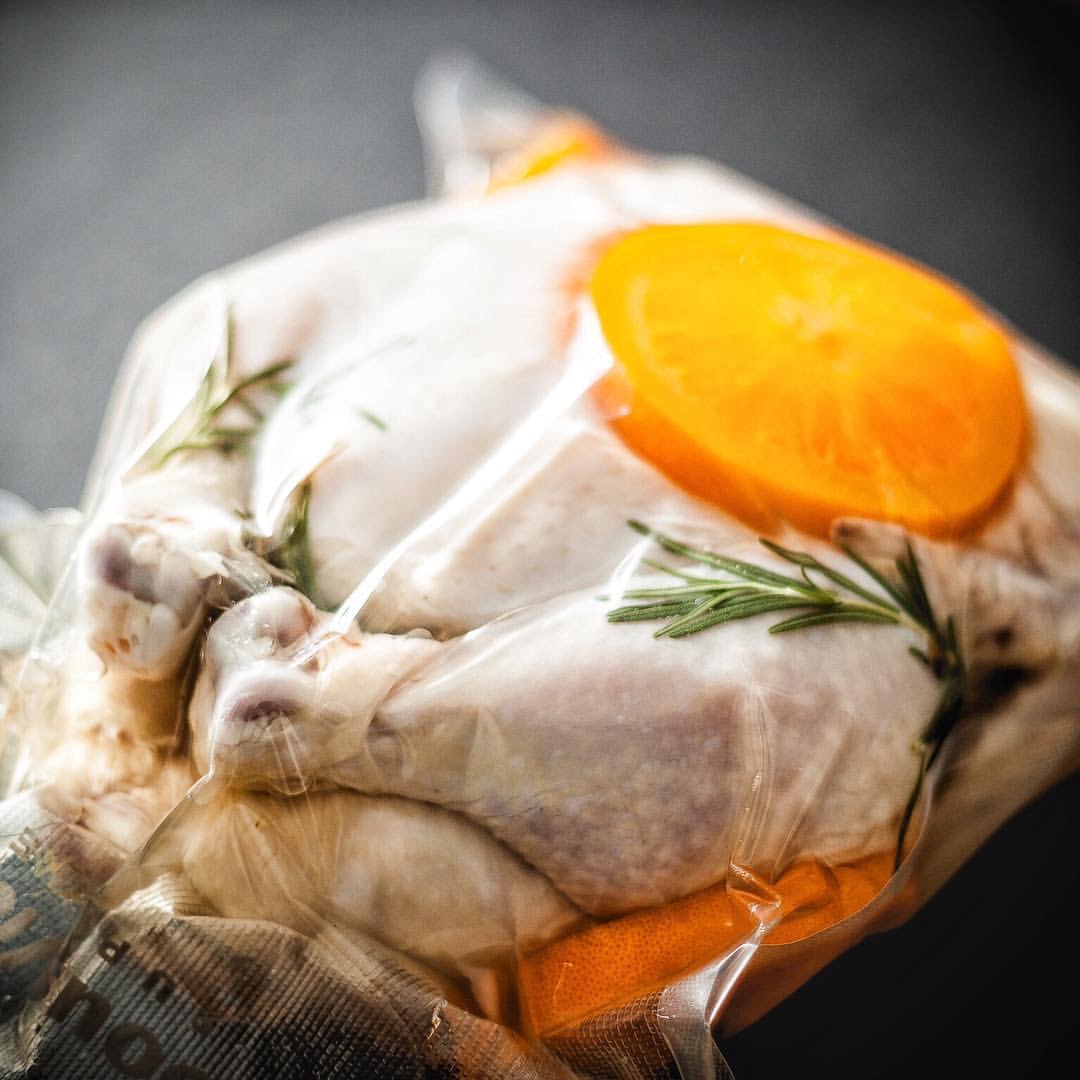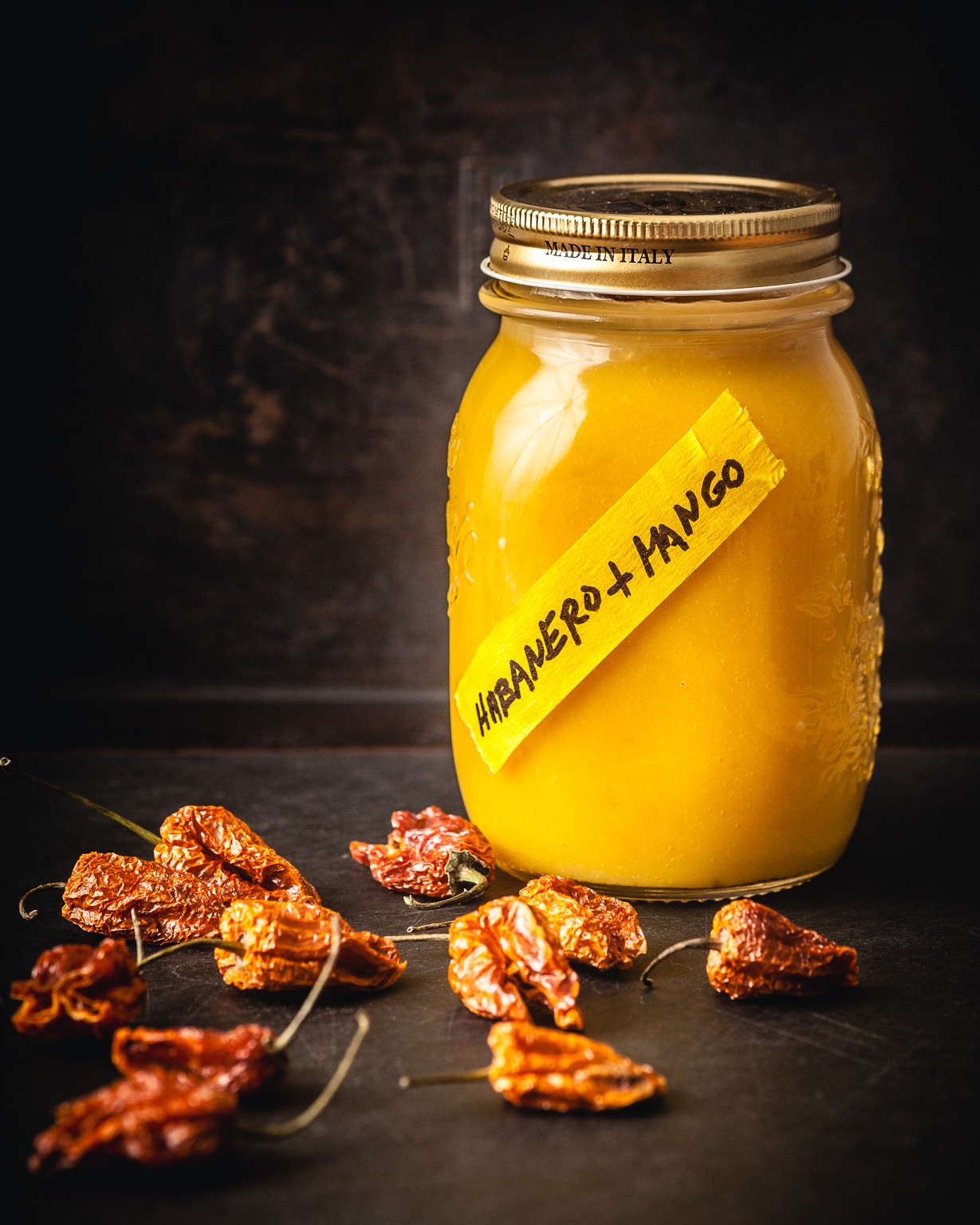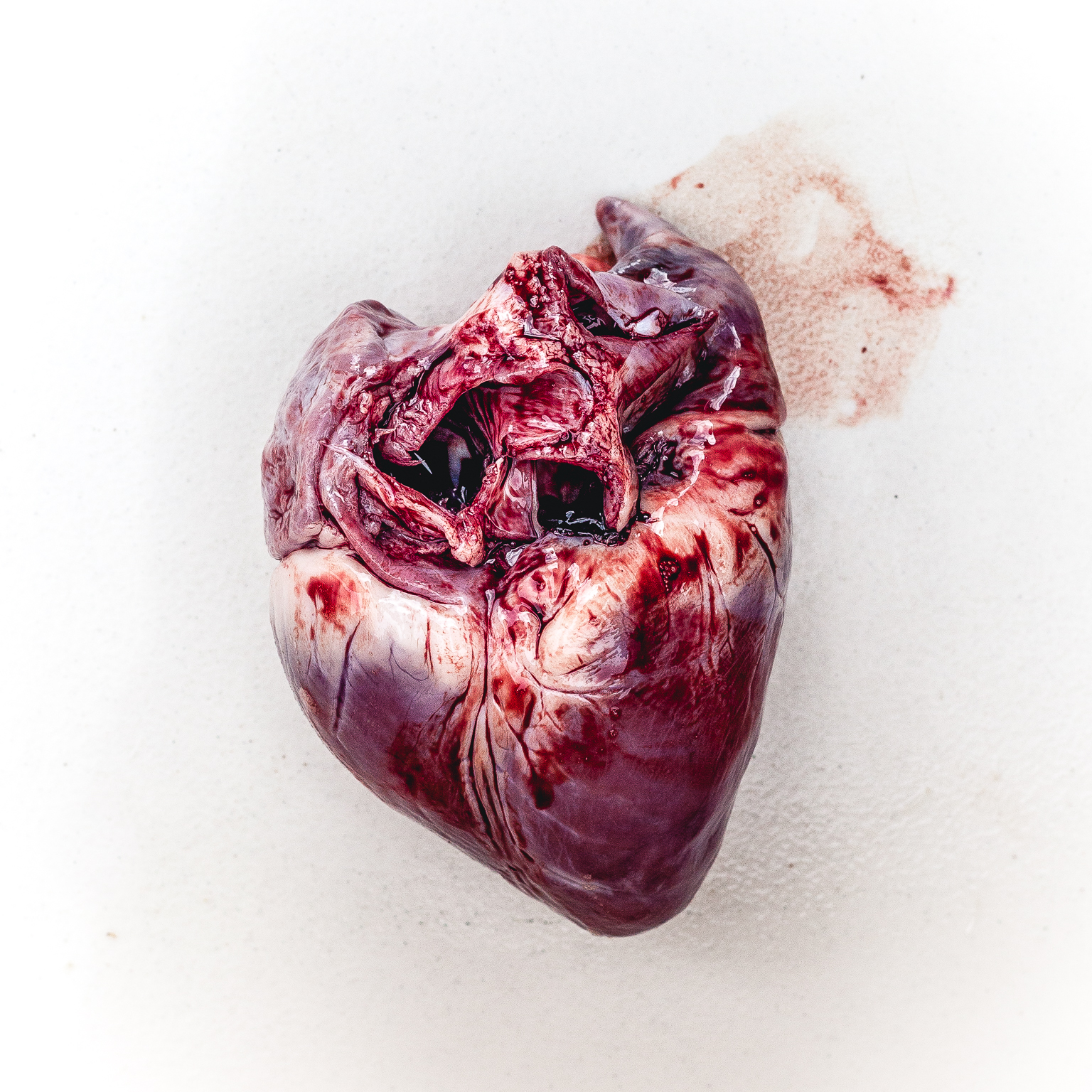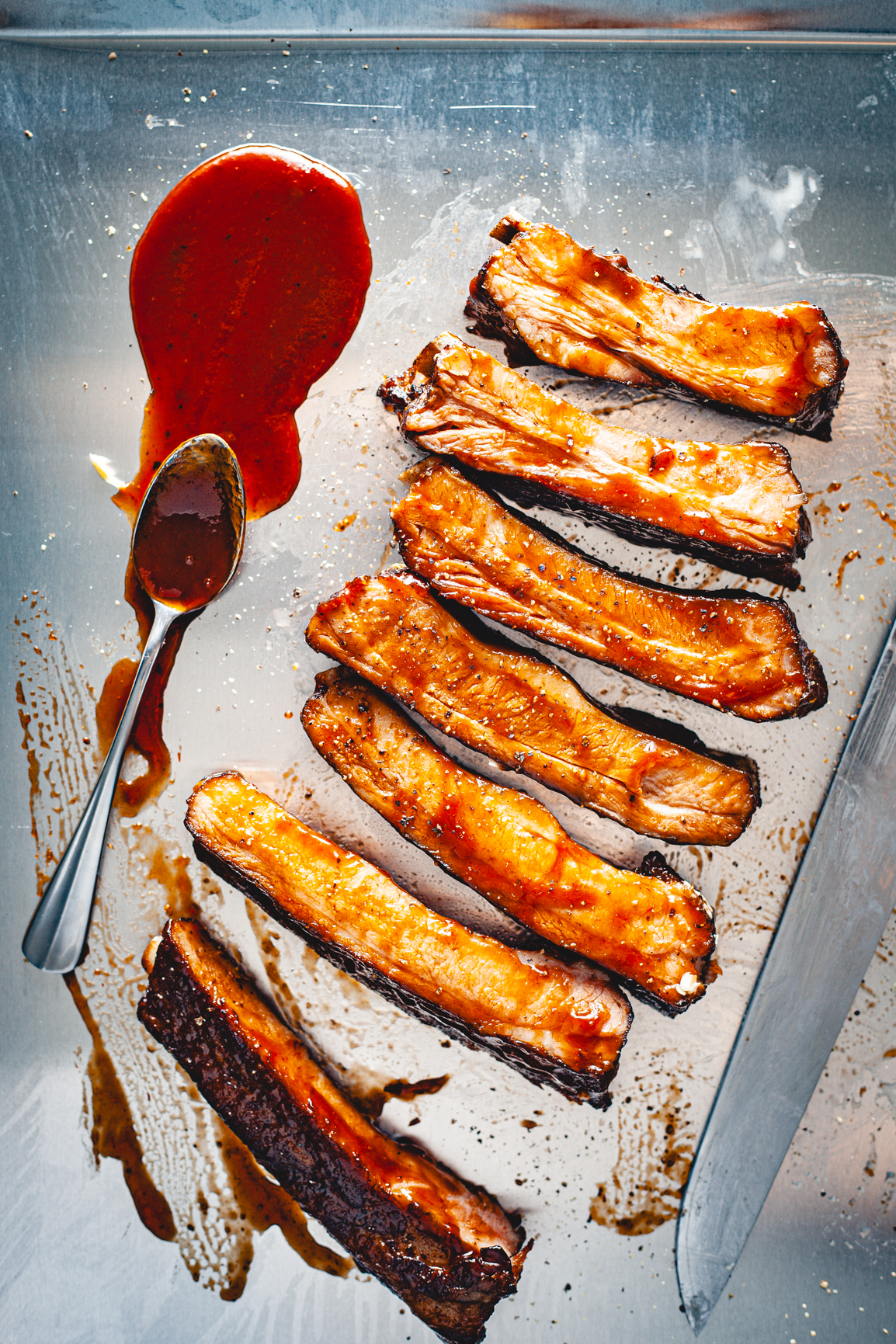I haven’t found a lot of information on the matter. Seems a bit odd considering how much importance people give to the “cook until juices run clear” rule in a time when sous vide cooking is becoming more popular but maybe that’s just me not crawling the web more thoroughly. If you’ve seen any good source of info let me know please… and I gotta warn ya, this post is probably a little graphic and off-putting but if you’ve been reading this blog…it happens.
Juices don’t run clear at 62C no matter how long.
If you’ve cooked chicken sous vide at relatively low temperatures (62 C – 145F) you probably have run into the pink juice situation and not only pink juices but the meat is also a bit on the pink side (the dark meat especially). I spoke to some sous vide cooks about this and they definitely disregard this as an issue because it really isn’t. The color of the juices has little to do with safety if the food is properly pasteurized during the cooking process. If anything, this pink juice stuff is nothing but an aesthetics problem in my mind when you’re cooking sous vide. I’ve recently done some testing at 65C and still pretty pink.

What makes juices run pink?
Myoglobin is the protein responsible for those pink juices. There’s also blood in the bones, etc and it all contributes to juices taking on a reddish color. Now for juices to run clear, myoglobin and hemoglobin need to cook at a temperatures that ensures their coagulation. Cooking chicken at 62C doesn’t achieve this and juices will not run clear. USDA/FDA recommended temperatures of 74C will achieve this and take care of the color issue but will also ensure your chicken is overcooked, specially the white meat.

Are pink juices unsafe? well… it depends.
Pathogens will die if cooked at 62C just like they will at 74C, it might take a bit longer at 62C but pasteurization is definitely guaranteed. At 74C you can pasteurize the juices and also change its color to the universally appealing and glorious clear state. I cooked a whole chicken for 12 hours (there was brine in the bag ensuring the whole chicken was submerged to avoid any issues with uneven cooking or undercooking inside the thorax cavity). That’s about 10 hours longer than needed to ensure pasteurization all the way to the core and those juices ran pink everywhere as expected, perfectly pasteurized but perfectly pink juices. Collagen denatured too and a ton of it. The texture of the meat was very tender and the bone cartilage had softened drastically. The stock inside the baggie was rich in gelatine. The white meat was pretty much white but the dark meat had that pinkish look as expected.

The “cook until juices run clear” rule.
Anyways, it’s been drilled into our heads and for a good reason that juices should run clear after cooking chicken. It’s an easy visual indicator that the chicken has been cooked through and pasteurized. It’s a lazy yet effective rule that allows cooks to know when they’ve applied enough heat, achieved pasteurization and it will all be well after eating that deliciously overcooked chicken. Sous vide cooking relies on a more precise approach to ensuring the food is perfectly safe to eat and this has nothing to do with the color of the juices in cooked chicken. It’s all about pasteurization by the numbers, temperature and time. I will skip the details but this has all been more than well documented online, in books, etc.

Pink but perfectly pasteurized chicken but still…
It’s very difficult to sell any of this to most people though. Even if science is telling us that those juices are perfectly safe to eat even though they’re pink. Nobody wants to eat even slightly pink chicken or see chicken blood on their plates (the horror!). That just triggers all kinds of self-preservation alarms in people’s heads. Some chicken might contain more myoglobin than others. If you brine the chicken in an acidic solution that could also help the denaturing of myoglobin and hemoglobin so there’s a change that even if cooking sous vide at low temperatures you might have not seen this pink issue before. It’s also hard to run into this issue if cooking deboned chicken, or pieces individually as opposed to the whole chicken. I also wonder about the myoglobin content of chicken raised on hormone vs free-range organic chicken… happy chicken. Anyways, I will keep researching. There are so many variables and so many questions.

What about you? how do you feel?
How do you feel about this? Do you not get pink juices when cooking sous vide chicken? and if you do… how do you go about it? do you cook at higher temperatures just to get around this issue? do you care? do your guests care? I find this whole thing really interesting but I also need to run, please leave your input in the message section below!

Wanna get more sous-vide cooking guides and cool cooking how-to’s in your mailbox? You know what needs to be done!
We never spam. You should only be getting updates when new content is posted on the site. We also respect your privacy. We don’t share your email address with anyone and you can unsubscribe anytime!





17 comments
I think you may have run before proofreading that! 🙂
I can’t think of any circumstance in which I’d need to sous vide a whole chicken. Why did you need to do it? Cooking in pieces, I’ve never noticed the pink juice problem. Perhaps my sous viding at 65ºC has something to do with it. Nevertheless, the chicken always needs something else doing to it before serving hot, either searing or being sauced, which also deals with or masks the pink. If the chicken is needed cold then the gelatinised juices get scraped away anyway when I slice or dice and the pink gets cooked out in stock.
tl;dr version – it’s not a problem:-)
Also (sorry – I should think things through before posting!), the 65ºC is for breast meat only; the pink juices are minimal. I would always cook legs and thighs separately, and at 75C so no pink issues. While 62ºC is enough to pasteurise I do find that the texture of the meat, breast in particular, is unpleasantly bouncy. I guess a lifetime of eating ‘cooked ’til the juices run clear’ chicken is responsible for conditioning my palate to that!
No worries, it’s all good! I like cooking chicken breasts at 58C for example (it’s all personal preference really, I’m sure that tons of people love their chicken cooked at a 100C just like most restaurants serve it) I guess the reason I wrote this article was to see how people out there were dealing with the juice color issue if cooking at similar low cooking temperatures. In regard to cooking a whole chicken sous vide… it really isn’t that uncommon and it’s hardly any different from roasting a whole chicken in the oven. The fact that the chicken is all in one piece is for convenience mainly. I’ve poached whole chickens too which is more similar to cooking a whole chicken sous vide. Chefsteps suggest 65C for a whole chicken cooked sous vide but I like 62C for 12 hours to get that confit texture on the dark meat. I also find that 62C allows me to get a pretty juicy fried chicken including the breasts. Thanks for sharing your thoughts! it’s always great to bounce ideas with other passionate cooks!
Paul,
If you’ve never been on the Amazing Ribs site you should. It’s an excellent resource especially for griling/bbq and they have this article which might be useful to you: http://amazingribs.com/tips_and_technique/mythbusting_chicken_is_done_when_juices_run_clear.html
Hi Enassar, yeah, I’ve read this article and it’s probably the best source out there for chicken cooking and the role of cleat juices. I think the lack of information online simply reflects the fact that nobody wants to admit their sous vide chicken juices weren’t exactly clear but that’s exactly what happens. I like cooking chicken breasts at 58C, that’s even lower than my example here, and if you cook bone-in chicken breasts, rest assured there will be pink in there 🙂 Totally and perfectly pasteurized pink.
Agreed about bone in chicken. I frequently bone out cuts like thighs if I’m cooking SV mainly for that reason and…maybe it’s all perception…but i think the “bone stains” on the meat taste a bit off to me.
I chew the caps off the bones hahah, I love the taste of chicken bone marrow too… I’m a hopeless carnivore 🙂 Im the worst basically! But if I’m cooking for my girlfriend then those juices better run clear hahahah
whole poached 62 deg chicken for 12 hours you say? interesting… all other recipes I have found say 65deg.. will try it out… !
modernist cuisine suggests 62c 12h for making chicken thigh/leg confit. Its borderline too low but interesting to test. Makes for a really great fried chicken if you asked me 🙂 Use baking soda in your flour mix to speed up browning time.
I’ve run into the pink juice dilemma several times when sousviding ChefSteps’s whole chicken . While I don’t mind it, non of my guests and my wife would touch it. I remedied the problem by dipping the pink parts in simmering hot water. The poached chicken, after 5 hours, was delicious and produced a collagen rich broth that was amazingly flavourful.
Yeah, I don’t mind it either but my girlfriend won’t even look at it 🙂 No matter how I explain it’s perfectly pasteurized. I usually bread and deep fry this whole sv chicken (after cutting up all the parts of course) which takes care of the problem for the most part and it’s probably the juiciest fried chicken one can ever have.
Hi Paul, myoglobin does lose its red color at 62C, even at 60C, but it will take a lot longer. To deal with the issue I use two strategies:
1) deboned chicken won’t have those bad looking red spots when cooked at 62C, even after a few hours
2) I cook chicken legs on the bone for as long as 72 hours at 60C — this only works for older chickens (like stewing hens) though — that is long enough for the myoglobin to break down and it also makes such tough chicken tender
The clear running juices is an indication that the leg meat has been cooked to over 70C, which in my book is overcooked.
I wrote an article about food safety that you may find interesting. https://stefangourmet.com/2016/11/27/understanding-food-safety/
Hey Stefan! Nice food safety article. I’ve been thinking about writing one too. I wanna talk about botulism a bit more because that’s one of those pathogens that sous vide cooking can’t necessarily kill. Where did you learn about myoglobin losing its read at low temp? anyways, thanks for sharing that!
I read about the myoglobin in Modernist Cuisine.
cool, I’ll check it out
I had a chicken leg cooked this way from HumgryRoot last night. It didn’t run pink, it was dark red, the juice and the meat at the bone. Thoughts?
Do you remember how long and what temp you used? At 145F overnight, that chicken should be pretty well cooked. Pink juices though. Was your chicken frozen when you started the cook? Even if you see bloody-looking juices cutting around the joins/bone it should all be cooked through and pasteurized. It might not look appetizing but it’s safe to eat. Most sous vide chicken recipes will call for boneless meat.